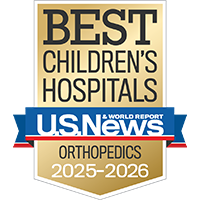Femoral retroversion

What is femoral retroversion?
Femoral retroversion is an outward rotation of the thigh bone (femur), causing the knee and toes to also turn outward. Usually both legs are affected.
The opposite condition, in which the femur turns inward, is called femoral anteversion. Unlike femoral anteversion, femoral retroversion isn't typically outgrown as the child matures. Surgical treatment is available for kids who experience pain or other troublesome symptoms.
The condition is also known as external femoral torsion or hip retroversion.
Awards & recognition
-

Ranked among the nation's best in 11 specialties
-

One of the nation's best for orthopedics
Causes of femoral retroversion
Femoral retroversion may result from the baby's position while growing in the uterus. It tends to run in families and is more common in kids with obesity.Symptoms of femoral retroversion
If your child has femoral retroversion, you may notice the following:
- The thigh bones turn outward from the hip.
- Both feet point outward when the child is walking. This is known as out-toeing or being duck-footed.
These differences can be caused by other conditions, and out-toeing can also be normal in young kids. Be sure to see a doctor to ensure your child is diagnosed correctly.
Diagnosis of femoral retroversion
To diagnose femoral retroversion, the doctor will perform a physical exam that includes assessing your child's hips. In kids with femoral retroversion, the hips have a greater-than-normal range of motion to the outside and a limited range of motion when rotated internally. Since the condition runs in families, the doctor may ask whether other family members have femoral retroversion.
X-rays usually aren't necessary. However, some children with femoral retroversion also have a condition called slipped capital femoral epiphysis, or SCFE. Kids who are experiencing pain, limping and out-toeing only on one side should be evaluated for SCFE, which does require imaging tests.
Treatment of femoral retroversion
Wearable devices, such as braces and twister cables, don't improve femoral retroversion. The only effective treatment is a surgical procedure called derotational osteotomy.
Surgery for femoral retroversion
In a derotational osteotomy, the surgeon cuts the femur, rotates it into proper alignment and reattaches the bone.
Surgery may be considered if your child has:
- Hip pain
- Significant abnormalities in gait (manner of walking)
- Activity limitations due to the condition
If you're considering this surgery for your child, look for a pediatric orthopedic surgeon with expertise in rotational problems.
This information is for educational purposes only and is not intended to replace the advice of your child's doctor or other health care provider. We encourage you to discuss any questions or concerns you may have with your child's provider.











































